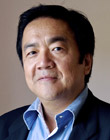From Innovations, a website published by Ziff-Davis Enterprise from mid-2006 to mid-2009. Reprinted by permission.
 John Kao (right) believes the United States has an innovation crisis, and he’s calling on today’s corps of young technology professionals to sound the alarm.
John Kao (right) believes the United States has an innovation crisis, and he’s calling on today’s corps of young technology professionals to sound the alarm.
Citing technology pioneer Vannevar Bush’s assertion more than 60 years ago that “A nation that loses its science and technology will lose control of its destiny,” Kao said the U.S. is in peril of becoming a technology laggard.
“The US public education system is veering further away from preparing kids for the world,” the author of Innovation Nation: How America Is Losing Its Innovation Edge, Why It Matters, and What We Can Do to Get It Back told the MIT Enterprise Forum early this month. “We spend more on education than any country in world, yet we’re between 24th and 29th in math performance.”
By contrast, Finland, a country that suffered a near economic collapse after the Soviet Union fell apart, today produces twice as many Ph.D.s per capita than the U.S. The Finns turned around their economy, in part, by creating a national design focused on science and technology education. As a result, “Two years ago, Finland was the number one competitive economy in the world, according to the World Economic Forum,” Kao said. “Its education system is rated the best in the world. People want to be teachers in Finland.”
We’ve heard this before, of course. In the late 1980s, Japan famously challenged the US for leadership in technology innovation with initiatives like the Fifth Generation Computer Project and a nationwide commitment to developing artificial intelligence. Those ambitious plans foundered, but Kao argues that this time is different.
Today, countries like Singapore and China are making technology innovation the centerpiece of a national strategy that’s backed by incentives, equipment and money. Singapore, for example, has set up the Biopolis, a $300 million biomedical research lab spread across a 10-acre campus. Singapore is allocating money to train expatriate scientists in other countries on the condition that they repay the government with six years of service. The country is also promising to remove the layers of bureaucracy and legal approvals that frustrate scientists in the U.S.
Singapore has convinced top researchers from MIT and the U.S. Centers for Disease Control to pull up stakes and move to the tiny nation-state with financial incentives and promises of academic freedom.
This last point is a key difference between the national technology policies of today and the failed models of two decades ago. Thanks to the Internet and business globalization, countries now have the capacity to build very large local industries serving overseas customers. Kao told of a friend who’s building a global travel business for 1/10th of what it would have cost a decade ago. He farms out much of the development work overseas. “Countries want to ally with American intellectual capital,” he said.
Therein lies a challenge for US competitiveness. The United States has long been able to rely upon the global brain drain from other countries to fuel its innovation economy. Over half of the engineering Ph.D.s awarded in the U.S. now go to foreign-born students. Many of those people have traditionally settled in Silicon Valley or other technology-rich environments. But the lifestyle trade-offs aren’t as dramatic as they used to be. “Now there’s an Apple store and a Starbucks in Bangalore [India],“ Kao said.
With overseas economies offering tax havens, comfortable salaries, research grants and other perks to technology achievers, some countries that used to lose talent to the US have actually reversed the migration.
What can US technology professionals do? Well, on a purely selfish level there may be some attractive opportunities to pull up stakes and move overseas. Singapore, for example, has earmarked a half billion dollars to fund digital imagine research. But if you’re more interested in improving the domestic situation, then start by voting for candidates that have a vision and a plan for US technology competitiveness.
You can also out into the classroom and share your own experiences with tomorrow’s innovators. Many teachers would be glad for the help. In John Kao’s words, “Many people who teach math and science in U.S. public schools are forced to do it.” In contrast, “In China, people with masters degrees in math willingly come in to teach in the schools.”
